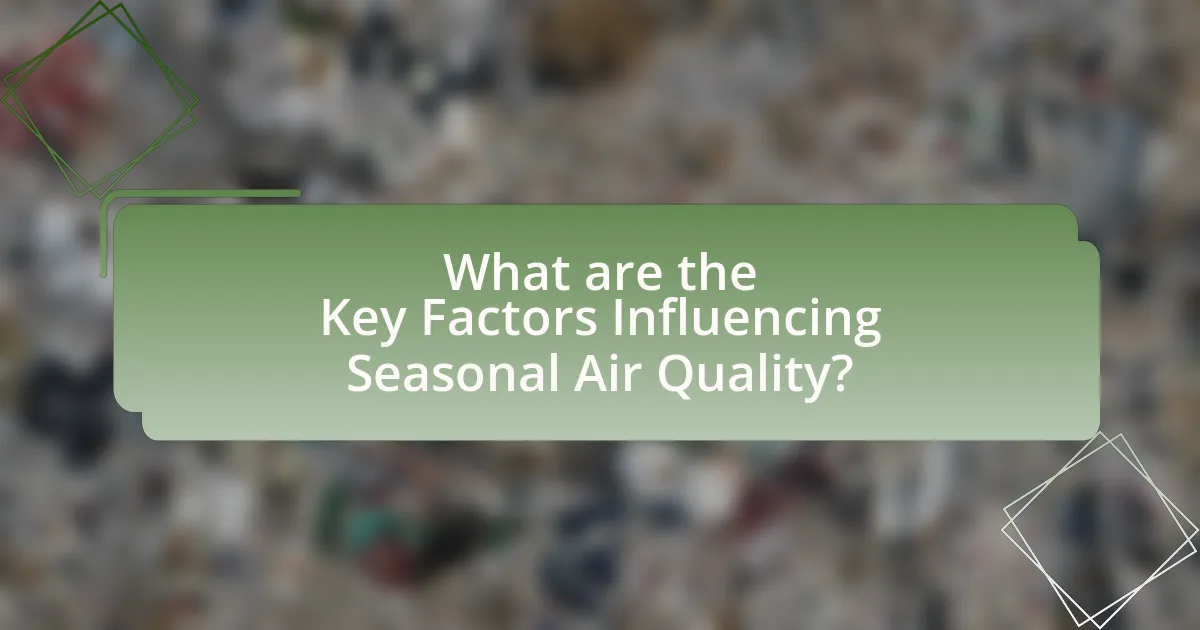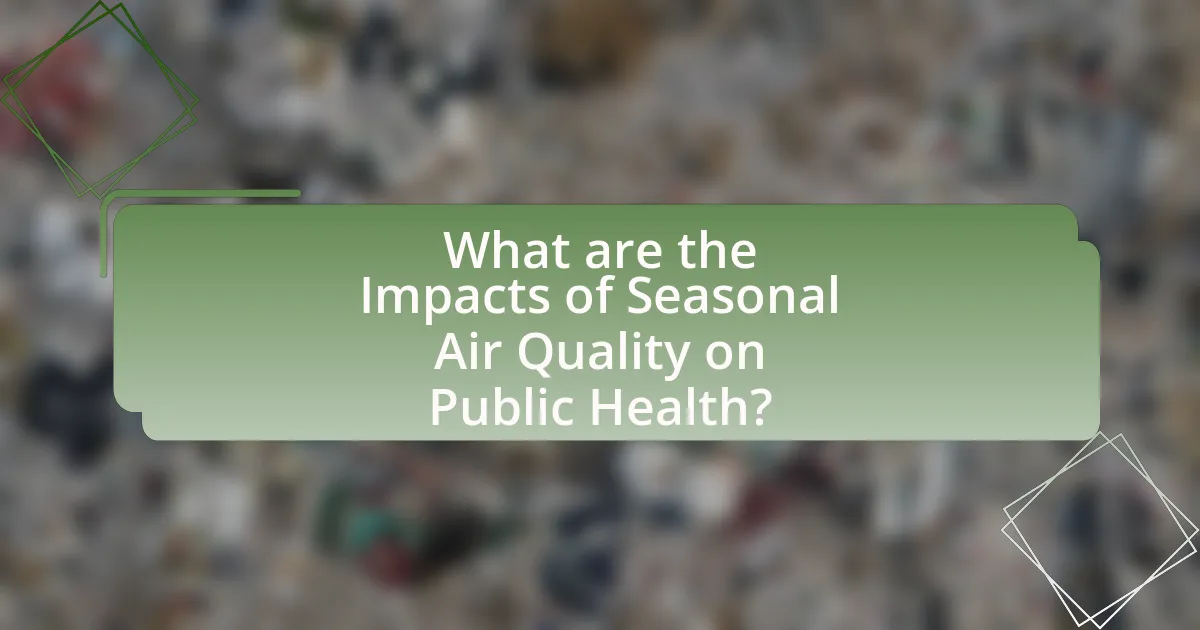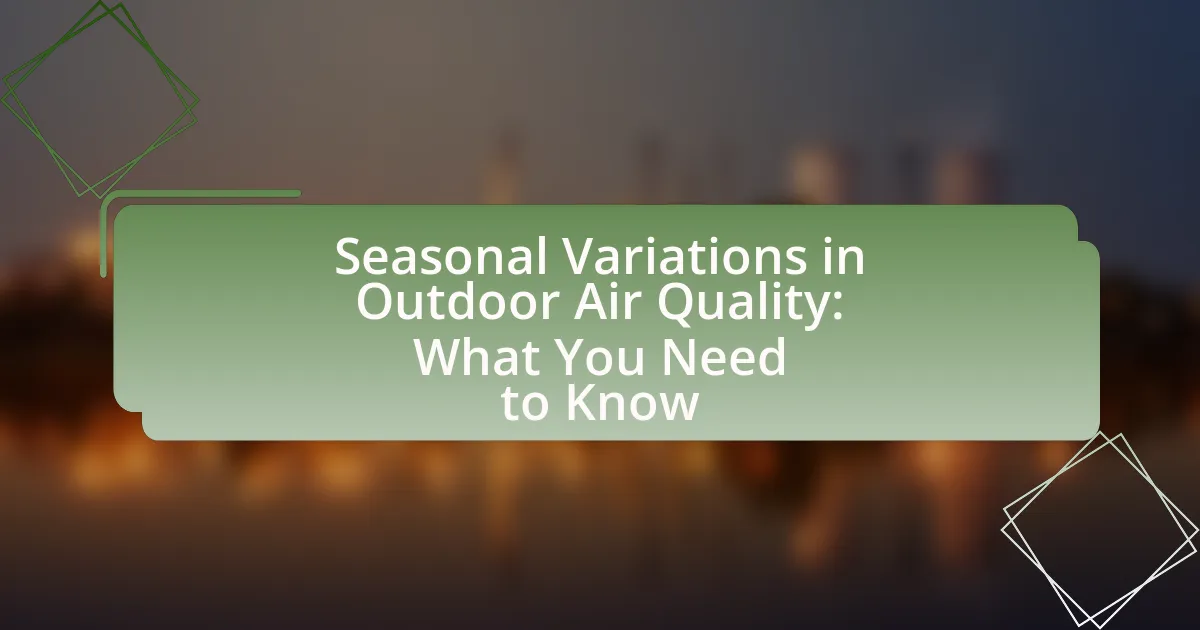Seasonal variations in outdoor air quality refer to the fluctuations in pollutant concentrations and overall air quality that occur throughout the year, influenced by factors such as temperature, humidity, and human activities. This article examines how seasonal changes affect specific pollutants like ozone, particulate matter, and nitrogen dioxide, highlighting the health implications associated with these variations. It also discusses the economic impacts of poor air quality, the role of meteorological conditions, and human activities that contribute to seasonal changes. Understanding these dynamics is crucial for public health planning and implementing effective air quality management strategies.
What are Seasonal Variations in Outdoor Air Quality?

Seasonal variations in outdoor air quality refer to the changes in the concentration of pollutants and overall air quality that occur throughout different seasons of the year. These variations are influenced by factors such as temperature, humidity, vegetation, and human activities, which can lead to increased levels of certain pollutants during specific times. For instance, in winter, the use of heating can elevate levels of particulate matter and carbon monoxide, while summer can see higher ozone levels due to increased sunlight and heat, which facilitate chemical reactions in the atmosphere. Studies have shown that air quality can significantly fluctuate, with the American Lung Association reporting that certain regions experience worse air quality in specific seasons, impacting public health and environmental conditions.
How do seasonal changes affect outdoor air quality?
Seasonal changes significantly affect outdoor air quality by influencing pollutant levels and atmospheric conditions. For instance, during winter, increased heating leads to higher emissions of particulate matter and nitrogen oxides, while temperature inversions can trap pollutants close to the ground, worsening air quality. Conversely, summer often sees elevated ozone levels due to increased sunlight and heat, which facilitate the chemical reactions that produce ground-level ozone from precursor pollutants. Studies, such as those conducted by the Environmental Protection Agency, indicate that these seasonal variations can lead to fluctuations in air quality index (AQI) readings, with winter months often showing spikes in particulate matter and summer months exhibiting higher ozone levels.
What pollutants are most affected by seasonal variations?
Seasonal variations significantly affect pollutants such as ozone, particulate matter (PM), and nitrogen dioxide (NO2). Ozone levels typically rise in warmer months due to increased sunlight and temperature, which enhance the photochemical reactions that produce ozone from precursor pollutants. Particulate matter concentrations can vary with seasons, often peaking in winter due to increased heating activities and stagnant atmospheric conditions. Nitrogen dioxide levels can also fluctuate seasonally, primarily influenced by traffic patterns and meteorological conditions, with higher concentrations observed in colder months when heating is more prevalent. These variations are documented in studies such as the “Seasonal Variations of Air Quality in Urban Areas” published in Environmental Science & Technology, which highlights the impact of seasonal changes on specific pollutants.
How do temperature and humidity influence air quality?
Temperature and humidity significantly influence air quality by affecting the concentration of pollutants and the formation of secondary pollutants. Higher temperatures can increase the rate of chemical reactions that produce ground-level ozone, a harmful air pollutant, particularly in urban areas. For instance, studies have shown that for every 1°C increase in temperature, ozone levels can rise by approximately 3-5%.
Humidity also plays a crucial role; high humidity can lead to the formation of particulate matter, as moisture can facilitate the aggregation of pollutants. Additionally, elevated humidity levels can exacerbate the effects of temperature on air quality by trapping pollutants close to the ground, leading to poor air quality conditions. Research indicates that during humid conditions, the respiratory effects of air pollution can be intensified, impacting public health.
Why is understanding seasonal variations important?
Understanding seasonal variations is important because it directly influences outdoor air quality, affecting both human health and environmental conditions. Seasonal changes can lead to fluctuations in pollutant levels, such as increased ozone in warmer months and higher particulate matter in winter due to heating activities. Research indicates that air quality can vary significantly with seasons; for instance, the Environmental Protection Agency (EPA) reports that ground-level ozone levels typically peak in summer, while particulate matter often rises in colder months due to increased fossil fuel combustion. This knowledge is crucial for public health planning and implementing effective air quality management strategies.
How can seasonal air quality impact health?
Seasonal air quality can significantly impact health by exacerbating respiratory and cardiovascular conditions. During certain seasons, such as summer, increased levels of ozone and particulate matter can lead to higher incidences of asthma attacks and heart-related issues. For instance, the American Lung Association reports that poor air quality is linked to over 200,000 premature deaths annually in the United States, highlighting the direct correlation between seasonal air pollution and health risks. Additionally, seasonal allergens, such as pollen, can worsen allergic reactions and respiratory diseases, further illustrating the health implications of varying air quality throughout the year.
What are the economic implications of seasonal air quality changes?
Seasonal air quality changes have significant economic implications, primarily affecting healthcare costs, productivity, and property values. Poor air quality during specific seasons can lead to increased respiratory illnesses, resulting in higher healthcare expenditures; for instance, the American Lung Association reported that air pollution contributes to approximately $150 billion in healthcare costs annually in the U.S. Additionally, decreased air quality can reduce worker productivity due to health-related absences, with estimates suggesting that poor air quality can cost the U.S. economy up to $1 trillion in lost productivity each year. Furthermore, properties in areas with poor seasonal air quality may experience depreciation, as potential buyers often seek healthier environments, impacting real estate markets.
What are the Key Factors Influencing Seasonal Air Quality?

Key factors influencing seasonal air quality include meteorological conditions, emissions from various sources, and atmospheric chemistry. Meteorological conditions such as temperature, humidity, and wind patterns significantly affect the dispersion and concentration of pollutants. For instance, higher temperatures in summer can lead to increased ground-level ozone formation, while stagnant air can trap pollutants. Emissions from vehicles, industrial activities, and natural sources like wildfires vary seasonally, impacting air quality. For example, winter heating can increase particulate matter levels, while summer often sees spikes in ozone due to increased vehicular traffic and sunlight. Lastly, atmospheric chemistry plays a crucial role, as reactions between pollutants can change with seasonal variations in sunlight and temperature, further influencing air quality.
How do meteorological conditions affect air quality?
Meteorological conditions significantly influence air quality by affecting the dispersion and concentration of pollutants. Factors such as temperature, humidity, wind speed, and atmospheric pressure play crucial roles; for instance, higher temperatures can increase the formation of ground-level ozone, while stagnant air conditions can trap pollutants close to the ground, leading to poor air quality. Studies have shown that during temperature inversions, where warmer air traps cooler air at the surface, pollutant levels can rise sharply, as seen in urban areas during winter months. Additionally, wind can disperse pollutants, improving air quality, or, conversely, transport them from one area to another, exacerbating pollution levels.
What role does wind play in air quality variations?
Wind plays a crucial role in air quality variations by dispersing pollutants and influencing their concentration levels. When wind speeds increase, they can dilute airborne contaminants, leading to improved air quality in affected areas. Conversely, stagnant air conditions can trap pollutants, resulting in higher concentrations and poorer air quality. Studies have shown that regions with consistent wind patterns often experience lower levels of particulate matter and other pollutants compared to areas with limited wind movement, highlighting the direct impact of wind on air quality dynamics.
How do precipitation patterns influence pollutant levels?
Precipitation patterns significantly influence pollutant levels by affecting the dispersion and deposition of airborne contaminants. Rainfall can wash pollutants out of the atmosphere, leading to lower concentrations of particulate matter and other pollutants in the air. For instance, studies have shown that heavy rainfall can reduce particulate matter levels by up to 50% in urban areas, as documented in research published in the journal Environmental Science & Technology. Conversely, dry periods can lead to increased pollutant levels due to stagnant air and lack of cleansing precipitation, which allows pollutants to accumulate. Thus, the relationship between precipitation and pollutant levels is crucial for understanding air quality dynamics.
What human activities contribute to seasonal air quality changes?
Human activities that contribute to seasonal air quality changes include industrial emissions, vehicle exhaust, agricultural practices, and residential heating. Industrial emissions release pollutants such as sulfur dioxide and nitrogen oxides, which can increase during colder months due to higher energy demands. Vehicle exhaust, particularly from gasoline and diesel engines, contributes to elevated levels of particulate matter and ozone, with variations depending on traffic patterns that change seasonally. Agricultural practices, including the use of fertilizers and pesticides, can lead to increased ammonia levels in the air, particularly during planting and harvest seasons. Additionally, residential heating, often reliant on fossil fuels, can significantly raise emissions of particulate matter and volatile organic compounds during winter months. These activities collectively influence air quality, leading to seasonal variations in pollutant concentrations.
How does traffic volume vary with seasons and affect air quality?
Traffic volume typically increases during warmer months and decreases in colder months, which directly impacts air quality. Higher traffic volumes in spring and summer lead to elevated emissions of pollutants such as nitrogen oxides and particulate matter, contributing to poor air quality. For instance, studies have shown that urban areas experience a 20-30% increase in vehicle emissions during peak travel seasons, correlating with higher ozone levels and respiratory issues. Conversely, winter months often see reduced traffic due to adverse weather conditions, resulting in lower emissions and improved air quality.
What agricultural practices impact outdoor air quality seasonally?
Agricultural practices that impact outdoor air quality seasonally include tillage, crop burning, and the application of fertilizers and pesticides. Tillage can release dust and particulate matter into the air, particularly during dry seasons, while crop burning, often conducted in the fall or spring, emits significant amounts of smoke and pollutants. The use of fertilizers and pesticides can lead to the release of ammonia and volatile organic compounds, which can vary with seasonal application rates and weather conditions. Studies have shown that these practices contribute to increased levels of particulate matter and ozone, particularly during specific seasons when agricultural activities peak.
What are the Impacts of Seasonal Air Quality on Public Health?

Seasonal air quality significantly impacts public health by influencing respiratory and cardiovascular conditions. During certain seasons, such as winter and summer, increased levels of pollutants like particulate matter and ozone can exacerbate asthma, lead to respiratory infections, and increase hospital admissions. For instance, studies have shown that high ozone levels in summer correlate with increased emergency room visits for asthma attacks, particularly among children. Additionally, winter months often see elevated levels of particulate matter due to heating sources, which can lead to higher incidences of heart attacks and strokes. These seasonal variations in air quality underscore the need for public health interventions and policies aimed at reducing pollution during critical times of the year.
How do seasonal air quality variations affect respiratory conditions?
Seasonal air quality variations significantly impact respiratory conditions by altering the concentration of pollutants and allergens in the atmosphere. During spring and summer, increased pollen levels and higher ozone concentrations can exacerbate asthma and allergic reactions, leading to more frequent respiratory symptoms. Conversely, winter months often see higher levels of particulate matter due to heating emissions, which can worsen chronic respiratory diseases. Studies indicate that individuals with pre-existing respiratory conditions are particularly vulnerable; for instance, a study published in the American Journal of Respiratory and Critical Care Medicine found that elevated ozone levels during warmer months correlate with increased hospital admissions for asthma.
What specific pollutants are linked to seasonal health issues?
Specific pollutants linked to seasonal health issues include particulate matter (PM2.5 and PM10), ozone (O3), nitrogen dioxide (NO2), and pollen. Particulate matter, particularly during winter months due to increased heating, can exacerbate respiratory conditions. Ozone levels typically rise in warmer months, contributing to asthma and other respiratory problems. Nitrogen dioxide, often from vehicle emissions, can worsen air quality in urban areas year-round but has seasonal spikes. Pollen counts, which vary by season, can trigger allergic reactions and respiratory issues. These pollutants have been shown to correlate with increased hospital admissions and respiratory illnesses, as documented in studies by the Environmental Protection Agency and the World Health Organization.
How can vulnerable populations be protected during poor air quality seasons?
Vulnerable populations can be protected during poor air quality seasons by implementing targeted public health interventions and providing access to resources. These interventions include issuing air quality alerts, promoting the use of air purifiers in homes, and ensuring access to clean indoor environments. Research indicates that individuals with pre-existing health conditions, children, and the elderly are particularly susceptible to the effects of poor air quality, necessitating tailored strategies such as providing masks, encouraging reduced outdoor activities, and facilitating healthcare access during high pollution days.
What strategies can be implemented to mitigate seasonal air quality issues?
To mitigate seasonal air quality issues, implementing strategies such as enhancing public transportation, promoting the use of electric vehicles, and increasing green spaces is essential. Enhancing public transportation reduces the number of vehicles on the road, thereby decreasing emissions that contribute to poor air quality. Promoting electric vehicles further minimizes harmful pollutants, as they produce zero tailpipe emissions. Additionally, increasing green spaces can improve air quality by absorbing pollutants and providing oxygen, as supported by studies showing that urban greenery can significantly reduce particulate matter levels.
How can individuals reduce their exposure to seasonal air pollutants?
Individuals can reduce their exposure to seasonal air pollutants by staying indoors during high pollution days, using air purifiers, and wearing masks when outdoors. Staying indoors, especially during peak pollution hours, minimizes direct exposure to harmful particles and gases. Air purifiers equipped with HEPA filters can effectively remove particulate matter from indoor air, improving air quality. Additionally, wearing masks designed to filter out pollutants can provide a physical barrier against inhaling harmful substances. These strategies are supported by studies indicating that indoor air quality can significantly impact overall health, particularly during seasons with elevated pollution levels.
What community initiatives can improve air quality during critical seasons?
Community initiatives that can improve air quality during critical seasons include tree planting programs, promotion of public transportation, and local air quality monitoring efforts. Tree planting programs enhance air quality by absorbing carbon dioxide and releasing oxygen, with studies showing that urban trees can reduce air pollution levels by up to 30%. Promoting public transportation decreases the number of vehicles on the road, thereby reducing emissions; for instance, cities that invest in public transit see a significant drop in air pollutants. Local air quality monitoring efforts provide real-time data, enabling communities to respond quickly to pollution spikes, which is crucial during seasons prone to smog or wildfires.
What are some practical tips for monitoring seasonal air quality?
To effectively monitor seasonal air quality, utilize air quality monitoring apps and websites that provide real-time data on pollutants such as PM2.5, ozone, and nitrogen dioxide. These platforms often aggregate data from local monitoring stations and can alert users to changes in air quality levels. Additionally, consider investing in a personal air quality monitor that can measure indoor and outdoor air quality, allowing for a more comprehensive understanding of environmental conditions. Regularly check seasonal forecasts and pollution alerts from government agencies, as certain times of the year, like summer and winter, can see spikes in specific pollutants due to weather patterns and increased activity. Engaging with community resources, such as local environmental organizations, can also provide insights and updates on air quality trends in your area.

Leave a Reply